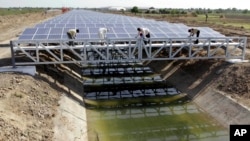Installing solar panels above the canals in the Gila River Indian Community will aid in water conservation.
In a move that may soon be replicated elsewhere, the Gila River Indian Community recently signed an agreement with the U.S. Army Corps of Engineers to put solar panels over a stretch of irrigation canal on its land south of Phoenix.
According to the tribe’s press release, this project will be the first of its kind in the United States to begin construction.
Governor Stephen Roe Lewis of the Gila River Indian Community called it a significant event for not only the community, but also the surrounding region and Indian Country as a whole. He made this statement in a video released on X (formerly known as Twitter).
The initial stage, expected to finish in 2025, will encompass a length of 1,000 feet of waterway and produce one megawatt of power which the tribe will utilize for watering crops, such as animal feed, cotton, and grains.
The concept is straightforward: place solar panels on top of canals in sunny, dry areas to decrease evaporation and produce sustainable energy.
Lewis expressed his pride in being at the forefront of water conservation and emphasized the importance of a Native, sovereign, tribal nation taking the lead in implementing this technology.
According to research from the University of California, Merced, covering the 4,000 miles of canals in California could potentially save 63 billion gallons of water every year. This idea has gained support from over 100 climate advocacy organizations.
Experts suggest that a large portion of the currently installed solar canopies have the potential to produce a substantial quantity of electricity.
UC Merced is working on improving its initial prediction and will have the opportunity to do so soon. In the Central Valley of California, the Turlock Irrigation District and Solar AquaGrid are planning to build 1.6 miles (2.6 kilometers) of solar canopies over their canals starting this spring. The advantages of this project will be examined by researchers.
The implementation of this technology is not exclusive to the Gila River Indian Community or the Turlock Irrigation District. In 2012, an Indian engineering firm, Sun Edison, was the first to introduce solar-covered canals on a major irrigation project in Gujarat state. However, despite plans to cover a vast distance of 11,800 miles (19,000 kilometers) of canals, only a few small projects were completed before the engineering firm declared bankruptcy.
According to experts, high expenses, unwieldy structure, and difficulties with upkeep were hindrances to the widespread use of the product.
However, the severe and long-lasting drought in the western United States has brought attention to water as a critical political concern. This has led to a greater interest in methods such as cloud seeding and using solar panels to cover canals, as water managers are desperate to find any solution to increase their water reserves. These methods may not have been extensively tested, but they are still being considered.
However, according to Heather Tanana, a visiting law professor at the University of California, Irvine and a citizen of the Navajo Nation, the project serves as a significant demonstration of the tribe’s dedication to preserving water. While some tribes are still resolving their water rights in legal disputes, they hold the highest priority for water rights on the Colorado River.
She mentioned that there is a lot of apprehension surrounding the tribes exercising their rights, as it may encroach on the rights of others. However, by leaving water in Lake Mead and using government funds for initiatives such as solar canopies, the tribe is demonstrating that this fear is unfounded.
The government has allocated a large amount of money towards initiatives that aim to conserve water. This includes a $233 million agreement with the Gila River Indian Community to save approximately two feet of water in Lake Mead, a major reservoir on the Colorado River that is currently experiencing severe depletion. The first phase of the solar canal project will require $6.7 million, with an additional $517,000 provided by the Bureau of Reclamation for the design.
Source: voanews.com




